2023 NISSAN LEAF warning
[x] Cancel search: warningPage 151 of 612
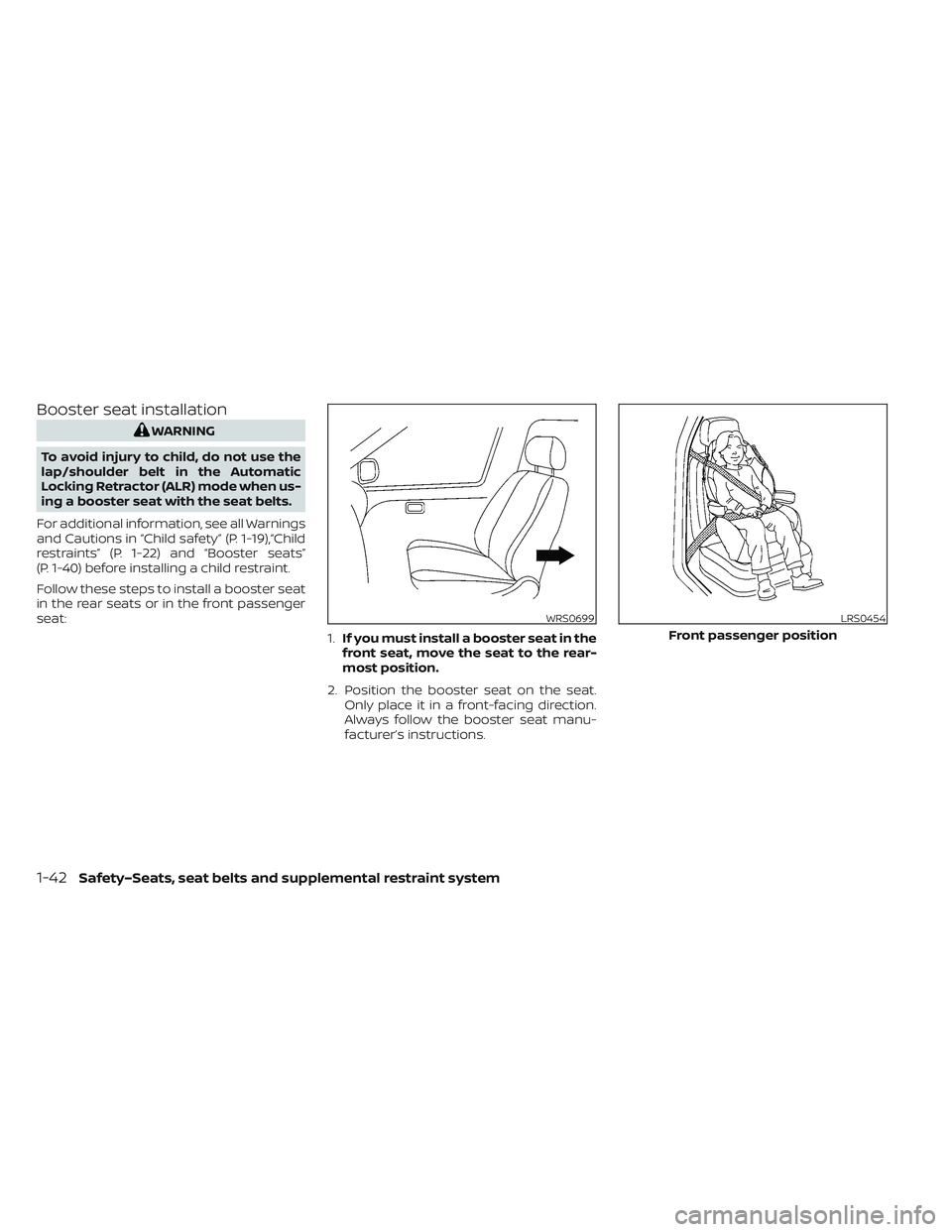
Booster seat installation
WARNING
To avoid injury to child, do not use the
lap/shoulder belt in the Automatic
Locking Retractor (ALR) mode when us-
ing a booster seat with the seat belts.
For additional information, see all Warnings
and Cautions in “Child safety” (P. 1-19),“Child
restraints” (P. 1-22) and “Booster seats”
(P. 1-40) before installing a child restraint.
Follow these steps to install a booster seat
in the rear seats or in the front passenger
seat: 1.If you must install a booster seat in the
front seat, move the seat to the rear-
most position.
2. Position the booster seat on the seat. Only place it in a front-facing direction.
Always follow the booster seat manu-
facturer’s instructions.
WRS0699LRS0454
Front passenger position
1-42Safety–Seats, seat belts and supplemental restraint system
Page 152 of 612
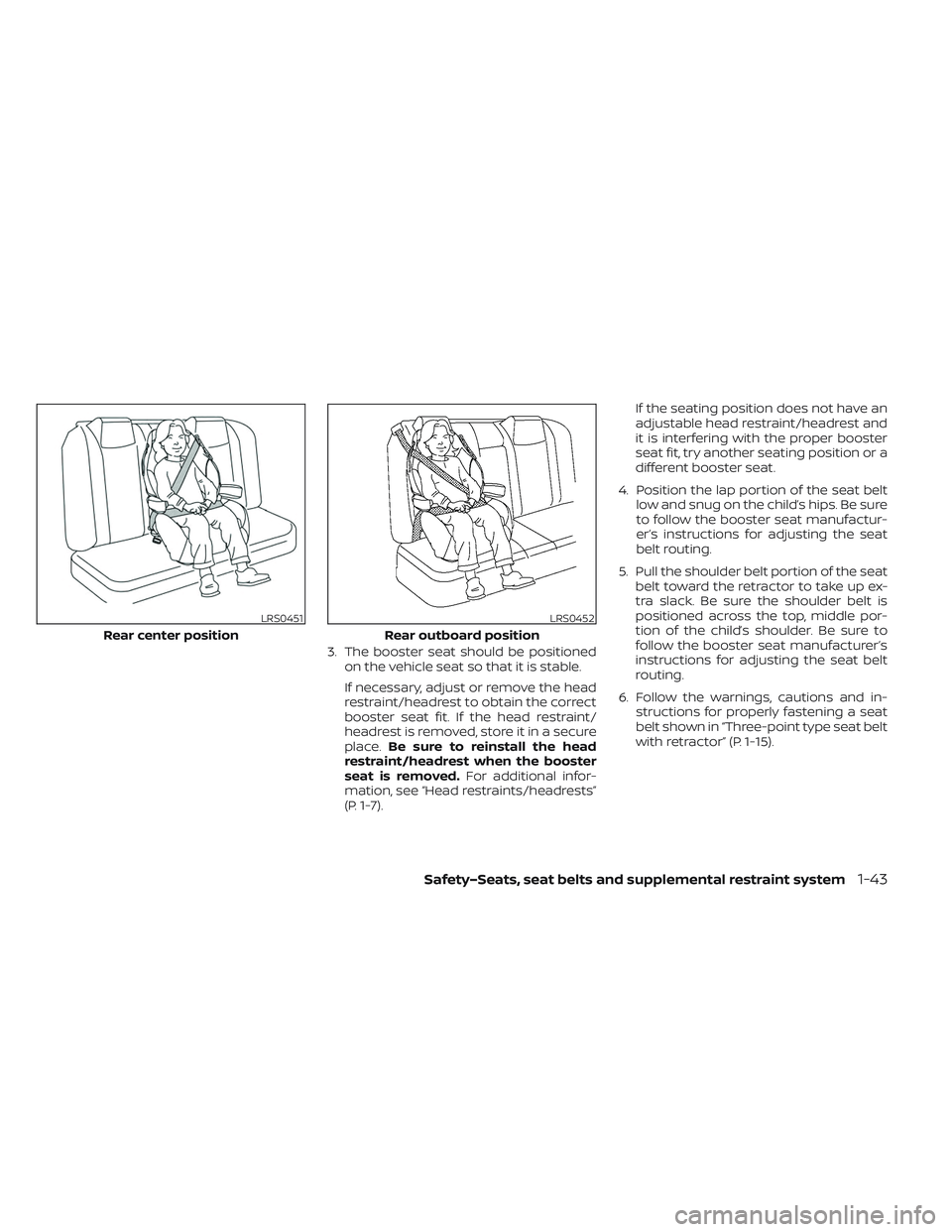
3. The booster seat should be positionedon the vehicle seat so that it is stable.
If necessary, adjust or remove the head
restraint/headrest to obtain the correct
booster seat fit. If the head restraint/
headrest is removed, store it in a secure
place. Be sure to reinstall the head
restraint/headrest when the booster
seat is removed. For additional infor-
mation, see “Head restraints/headrests”
(P. 1-7). If the seating position does not have an
adjustable head restraint/headrest and
it is interfering with the proper booster
seat fit, try another seating position or a
different booster seat.
4. Position the lap portion of the seat belt low and snug on the child’s hips. Be sure
to follow the booster seat manufactur-
er’s instructions for adjusting the seat
belt routing.
5. Pull the shoulder belt portion of the seat belt toward the retractor to take up ex-
tra slack. Be sure the shoulder belt is
positioned across the top, middle por-
tion of the child’s shoulder. Be sure to
follow the booster seat manufacturer’s
instructions for adjusting the seat belt
routing.
6. Follow the warnings, cautions and in- structions for properly fastening a seat
belt shown in “Three-point type seat belt
with retractor” (P. 1-15).
LRS0451
Rear center position
LRS0452
Rear outboard position
Safety–Seats, seat belts and supplemental restraint system1-43
Page 154 of 612
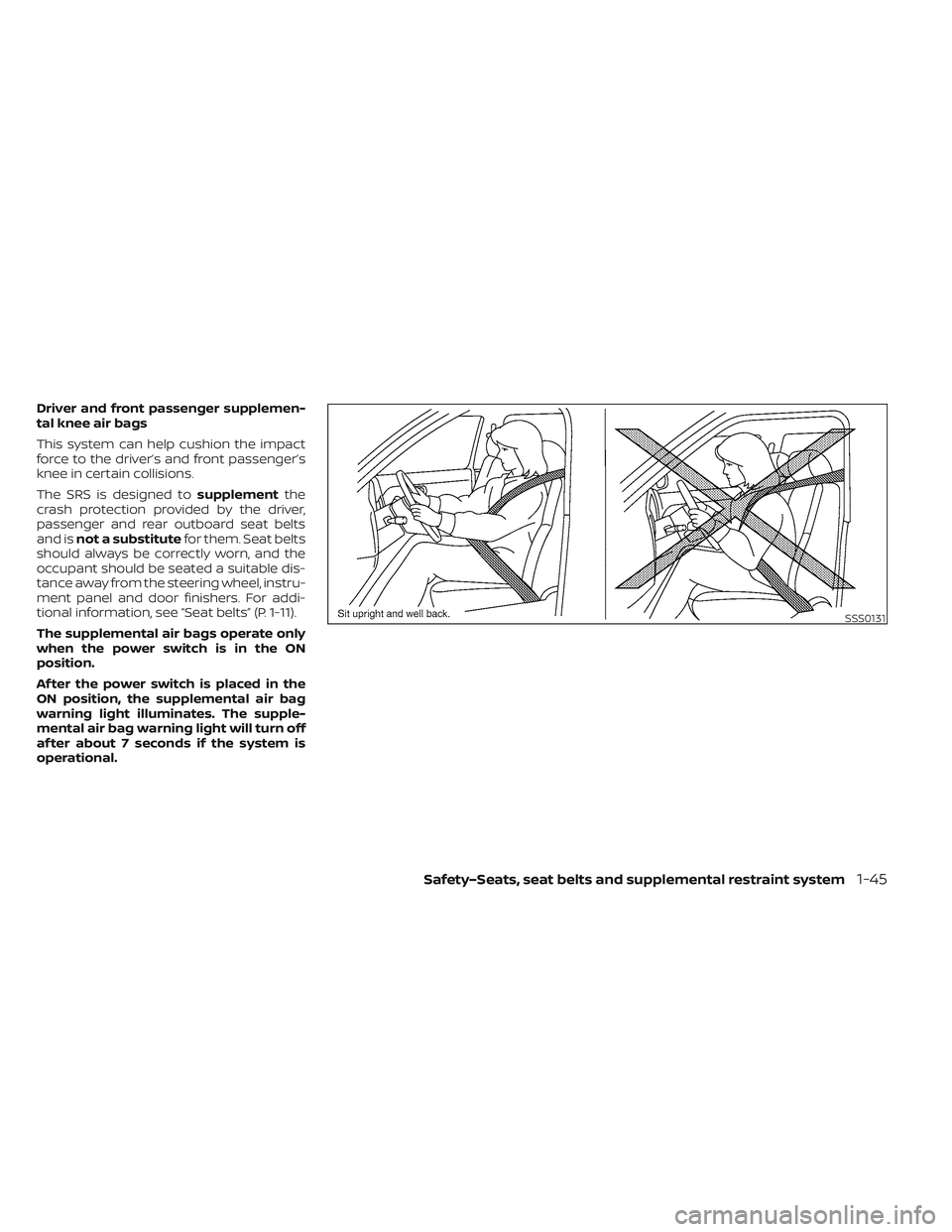
Driver and front passenger supplemen-
tal knee air bags
This system can help cushion the impact
force to the driver’s and front passenger’s
knee in certain collisions.
The SRS is designed tosupplementthe
crash protection provided by the driver,
passenger and rear outboard seat belts
and is not a substitute for them. Seat belts
should always be correctly worn, and the
occupant should be seated a suitable dis-
tance away from the steering wheel, instru-
ment panel and door finishers. For addi-
tional information, see “Seat belts” (P. 1-11).
The supplemental air bags operate only
when the power switch is in the ON
position.
Af ter the power switch is placed in the
ON position, the supplemental air bag
warning light illuminates. The supple-
mental air bag warning light will turn off
af ter about 7 seconds if the system is
operational.
SSS0131
Safety–Seats, seat belts and supplemental restraint system1-45
Page 155 of 612
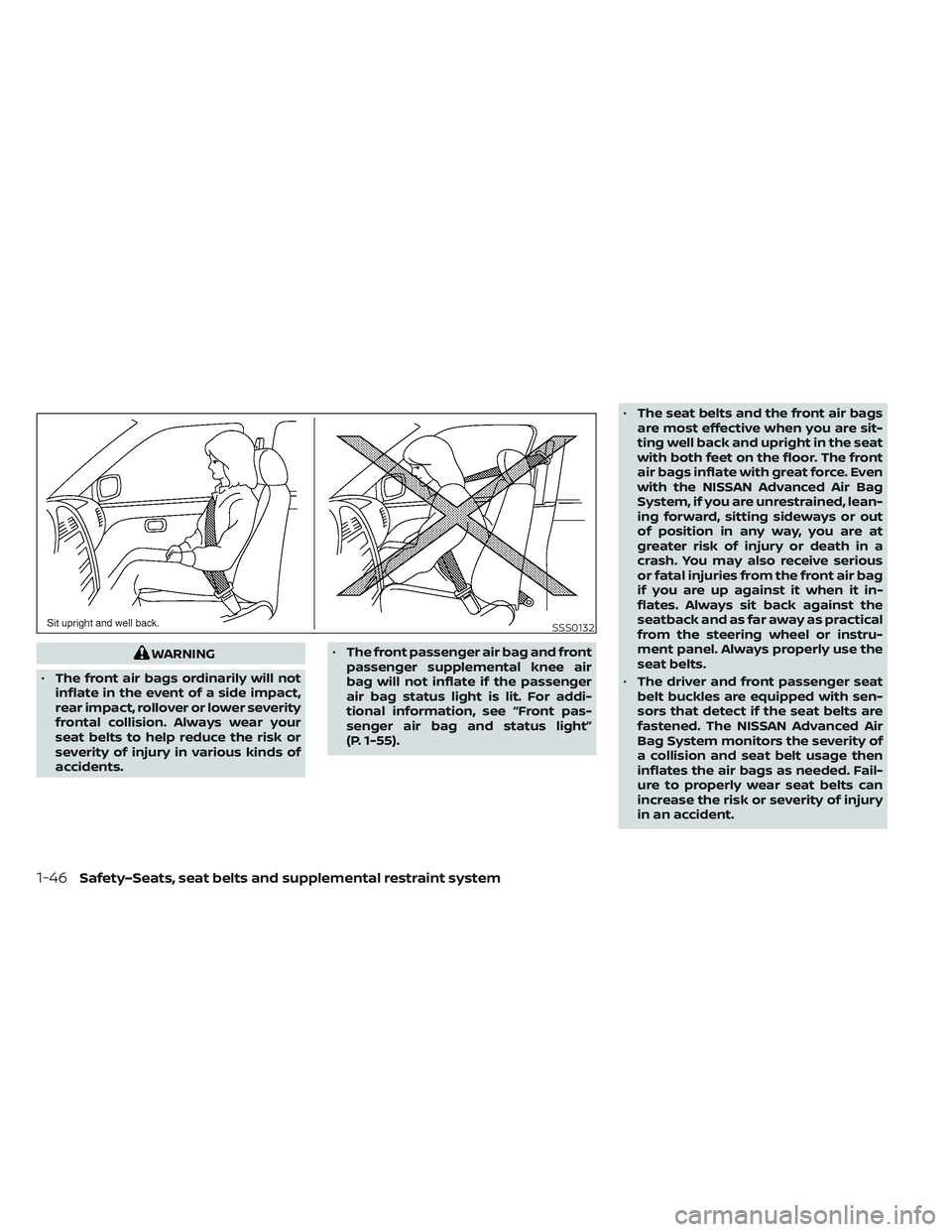
WARNING
• The front air bags ordinarily will not
inflate in the event of a side impact,
rear impact, rollover or lower severity
frontal collision. Always wear your
seat belts to help reduce the risk or
severity of injury in various kinds of
accidents. •
The front passenger air bag and front
passenger supplemental knee air
bag will not inflate if the passenger
air bag status light is lit. For addi-
tional information, see “Front pas-
senger air bag and status light”
(P. 1-55). •
The seat belts and the front air bags
are most effective when you are sit-
ting well back and upright in the seat
with both feet on the floor. The front
air bags inflate with great force. Even
with the NISSAN Advanced Air Bag
System, if you are unrestrained, lean-
ing forward, sitting sideways or out
of position in any way, you are at
greater risk of injury or death in a
crash. You may also receive serious
or fatal injuries from the front air bag
if you are up against it when it in-
flates. Always sit back against the
seatback and as far away as practical
from the steering wheel or instru-
ment panel. Always properly use the
seat belts.
• The driver and front passenger seat
belt buckles are equipped with sen-
sors that detect if the seat belts are
fastened. The NISSAN Advanced Air
Bag System monitors the severity of
a collision and seat belt usage then
inflates the air bags as needed. Fail-
ure to properly wear seat belts can
increase the risk or severity of injury
in an accident.
SSS0132
1-46Safety–Seats, seat belts and supplemental restraint system
Page 158 of 612
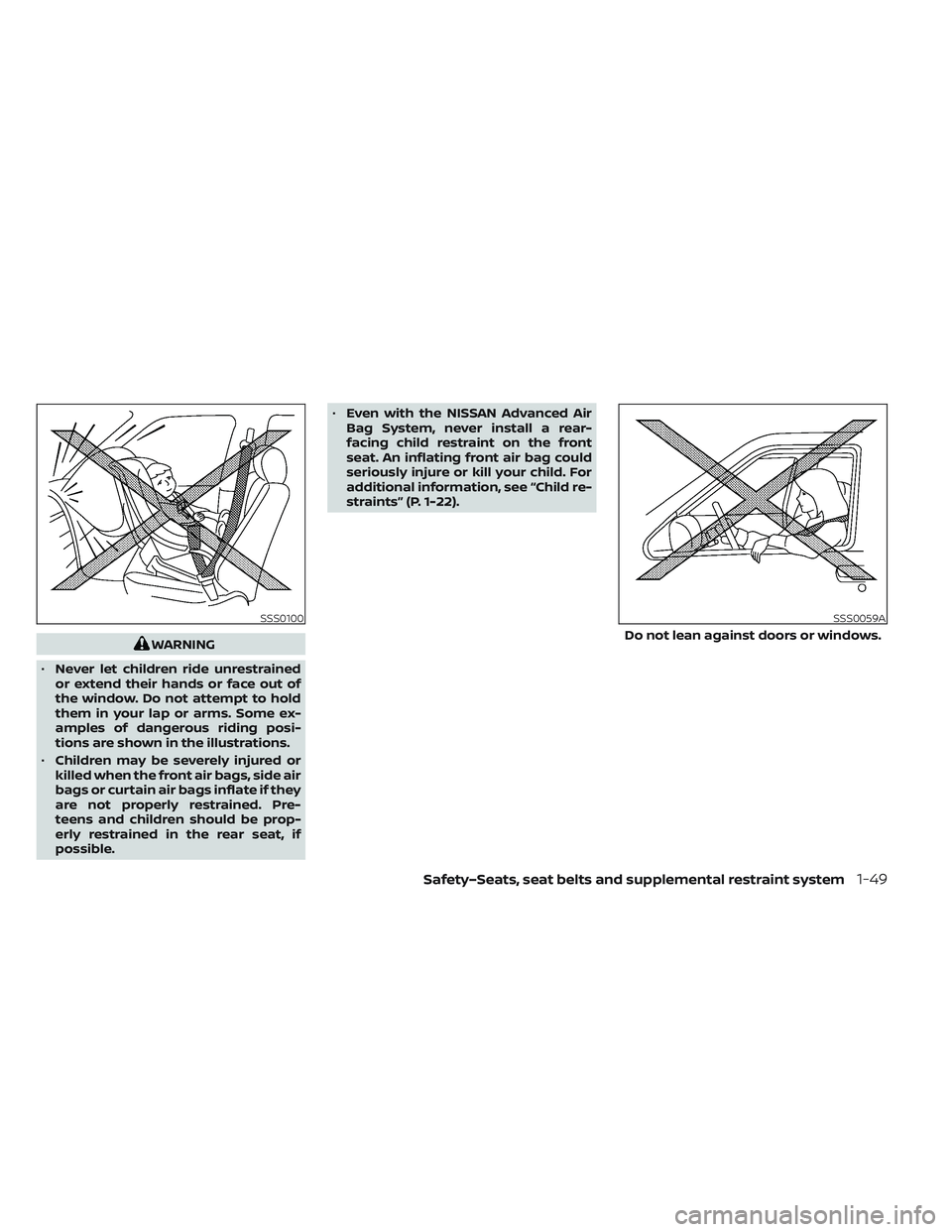
WARNING
• Never let children ride unrestrained
or extend their hands or face out of
the window. Do not attempt to hold
them in your lap or arms. Some ex-
amples of dangerous riding posi-
tions are shown in the illustrations.
• Children may be severely injured or
killed when the front air bags, side air
bags or curtain air bags inflate if they
are not properly restrained. Pre-
teens and children should be prop-
erly restrained in the rear seat, if
possible. •
Even with the NISSAN Advanced Air
Bag System, never install a rear-
facing child restraint on the front
seat. An inflating front air bag could
seriously injure or kill your child. For
additional information, see “Child re-
straints” (P. 1-22).
SSS0100SSS0059A
Do not lean against doors or windows.
Safety–Seats, seat belts and supplemental restraint system1-49
Page 160 of 612
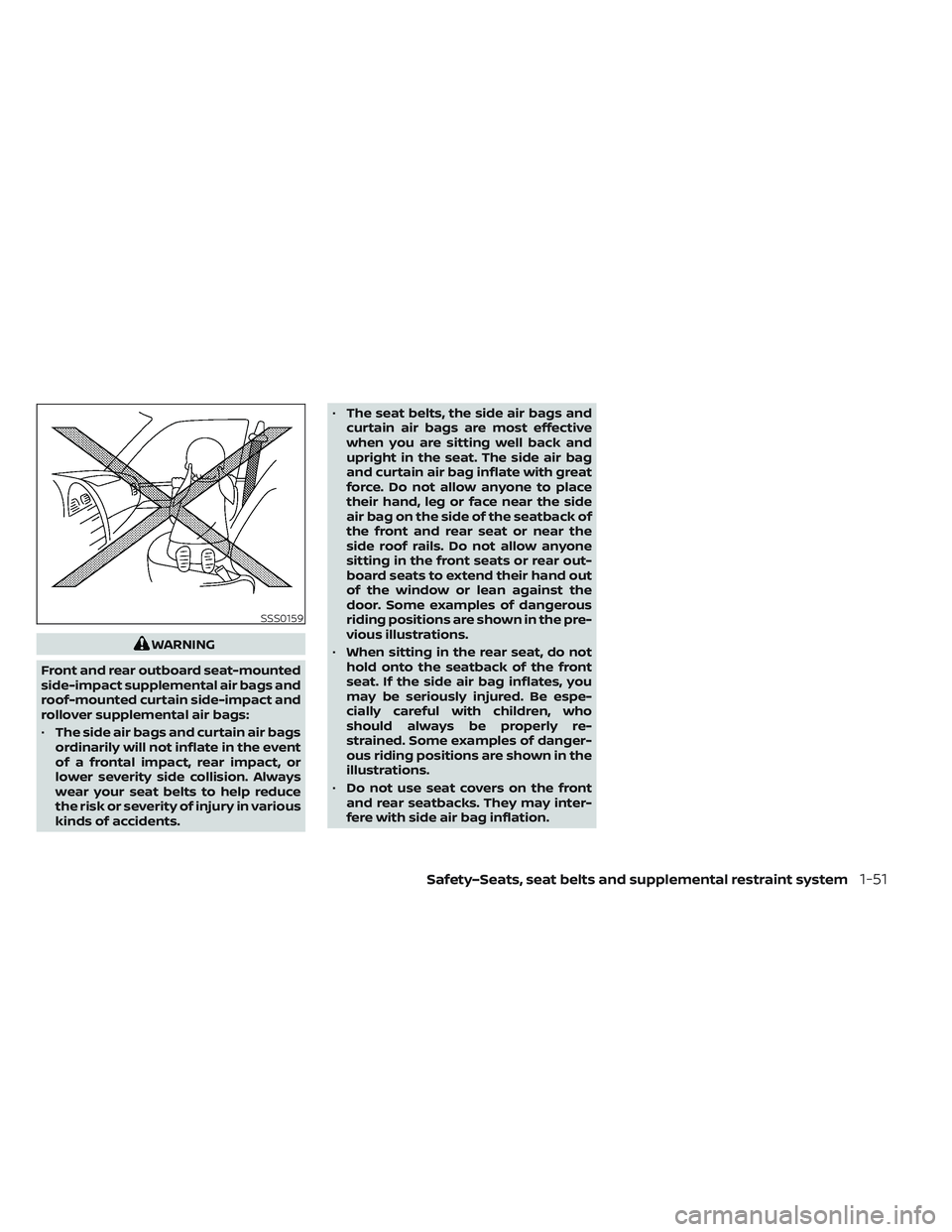
WARNING
Front and rear outboard seat-mounted
side-impact supplemental air bags and
roof-mounted curtain side-impact and
rollover supplemental air bags:
• The side air bags and curtain air bags
ordinarily will not inflate in the event
of a frontal impact, rear impact, or
lower severity side collision. Always
wear your seat belts to help reduce
the risk or severity of injury in various
kinds of accidents. •
The seat belts, the side air bags and
curtain air bags are most effective
when you are sitting well back and
upright in the seat. The side air bag
and curtain air bag inflate with great
force. Do not allow anyone to place
their hand, leg or face near the side
air bag on the side of the seatback of
the front and rear seat or near the
side roof rails. Do not allow anyone
sitting in the front seats or rear out-
board seats to extend their hand out
of the window or lean against the
door. Some examples of dangerous
riding positions are shown in the pre-
vious illustrations.
• When sitting in the rear seat, do not
hold onto the seatback of the front
seat. If the side air bag inflates, you
may be seriously injured. Be espe-
cially careful with children, who
should always be properly re-
strained. Some examples of danger-
ous riding positions are shown in the
illustrations.
• Do not use seat covers on the front
and rear seatbacks. They may inter-
fere with side air bag inflation.
SSS0159
Safety–Seats, seat belts and supplemental restraint system1-51
Page 162 of 612

WARNING
To ensure proper operation of the front
passenger’s NISSAN Advanced Air Bag
System, please observe the following
items.
• Do not allow a passenger in the rear
seat to push or pull on the seatback
pocket (if so equipped).
• Do not place heavy loads heavier
than 9.1 lbs. (4 kg) on the seatback,
head restraint/headrest or in the
seatback pocket (if so equipped).
• Make sure that there is nothing
pressing against the rear of the seat-
back, such as a child restraint in-
stalled in the rear seat or an object
stored on the floor.
• Make sure that there is no object
placed under the front passenger
seat.
• Make sure that there is no object
placed between the seat cushion and
center console or between the seat
cushion and the door. •
If a forward-facing child restraint is
installed in the front passenger seat,
do not position the front passenger
seat so the child restraint contacts
the instrument panel. If the child re-
straint does contact the instrument
panel, the system may determine the
seat is occupied and the passenger
air bag and front passenger supple-
mental knee air bag may deploy in a
collision. Also, the front passenger air
bag status light may not illuminate.
For additional information, see “Child
restraints” (P. 1-22).
• Confirm the operating condition with
the front passenger air bag status
light.
• If you notice that the front passenger
air bag status light is not operating
as described in this section, get the
occupant classification system
checked. It is recommended that you
visit a NISSAN certified LEAF dealer
for this service.
• Until you have confirmed with a
dealer that your passenger seat oc-
cupant classification system is work-
ing properly, position the occupants
in the rear seating positions. •
Do not position the front passenger
seat so it contacts the rear seat. If the
front seat does contact the rear seat,
the air bag system may determine a
sensor malfunction has occurred
and the front passenger air bag sta-
tus light may illuminate and the
supplemental air bag warning light
may flash.
This vehicle is equipped with the NISSAN
Advanced Air Bag System for the driver and
front passenger seats. This system is de-
signed to meet certification requirements
under U.S. regulations. It is also permitted in
Canada. All of the information, cautions
and warnings in this manual apply and
must be followed.
The driver supplemental front-impact air
bag is located in the center of the steering
wheel. The front passenger supplemental
front-impact air bag is mounted in the in-
strument panel above the glove box. The
front air bags are designed to inflate in
higher severity frontal collisions, although
they may inflate if the forces in another
type of collision are similar to those of a
higher severity frontal impact. They may
not inflate in certain frontal collisions. Ve-
hicle damage (or lack of it) is not always an
indication of proper front air bag operation.
Safety–Seats, seat belts and supplemental restraint system1-53
Page 163 of 612

The NISSAN Advanced Air Bag System
monitors information from the crash zone
sensor and the Air bag Control Unit (ACU).
Inflator operation is based on the severity
of a collision and seat belt usage for the
driver. For the front passenger, the occu-
pant classification sensor is also moni-
tored. Based on information from the sen-
sor, only one front air bag may inflate in a
crash, depending on the crash severity. Ad-
ditionally, the front passenger air bag and
front passenger supplemental knee air
bag may be automatically turned OFF un-
der some conditions, depending on the
weight detected on the passenger seat
and how the seat belt is used. If the front
passenger air bag and front passenger
supplemental knee air bag are OFF, the
passenger air bag status light will be illumi-
nated. For additional information, see
“Front passenger air bag and status light”
(P. 1-55). One front air bag inflating does not
indicate improper performance of the
system.
If you have any questions about your air
bag system, it is recommended that you
visit a NISSAN certified LEAF dealer to ob-
tain information about the system. If you
are considering modification of your ve-
hicle due to a disability, you may also con-tact NISSAN. Contact information is con-
tained in the front of this Owner’s Manual.
When a front air bag inflates, a fairly loud
noise may be heard, followed by release of
smoke. This smoke is not harmful and
does not indicate a fire. Care should be
taken not to inhale it, as it may cause irrita-
tion and choking. Those with a history of a
breathing condition should get fresh air
promptly.
Front air bags, along with the use of seat
belts, help to cushion the impact force on
the head and chest of the front occupants.
They can help save lives and reduce seri-
ous injuries. However, an inflating front air
bag may cause facial abrasions or other
injuries. Front air bags, other than the driv-
er’s and front passenger’s supplemental
knee air bags, do not provide restraint to
the lower body.
Even with NISSAN Advanced Air Bags, seat
belts should be correctly worn and the
driver and front passenger seated upright
as far as practical away from the steering
wheel or instrument panel. The front air
bags inflate quickly in order to help protect
the front occupants. Because of this, the
force of the front air bag inflating can in-
crease the risk of injury if the occupant is
too close to, or is against, the air bag mod-
ule during inflation.
The front air bags deflate quickly af ter a
collision.
The front air bags operate only when the
power switch is in the ON position.
Af ter the power switch is placed in the
ON position, the supplemental air bag
warning light illuminates. The supple-
mental air bag warning light will turn off
af ter about 7 seconds if the system is
operational.
1-54Safety–Seats, seat belts and supplemental restraint system